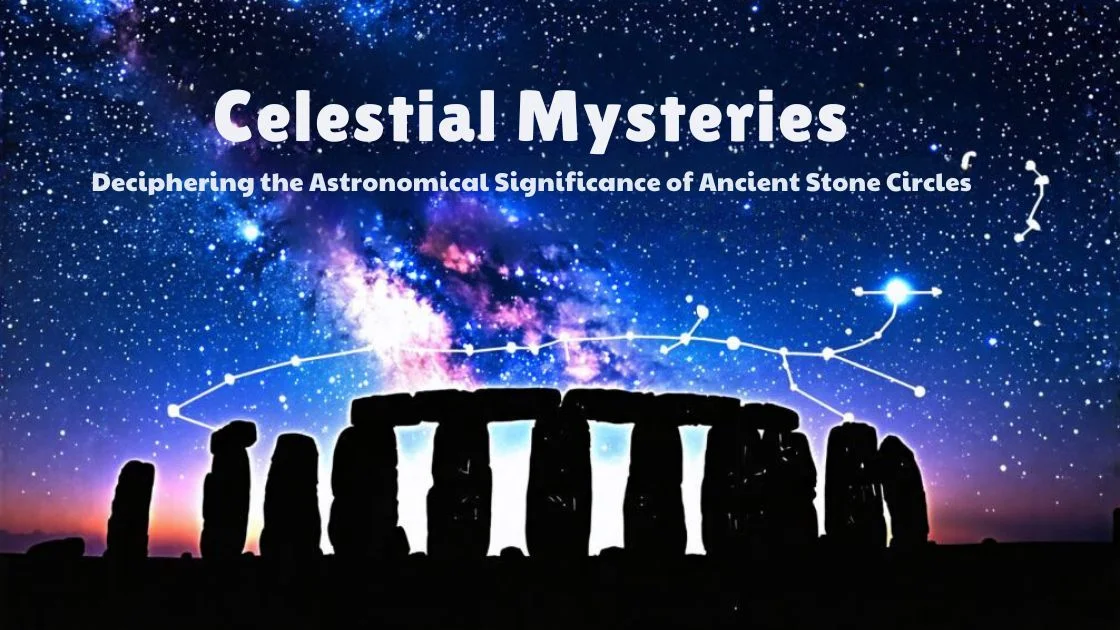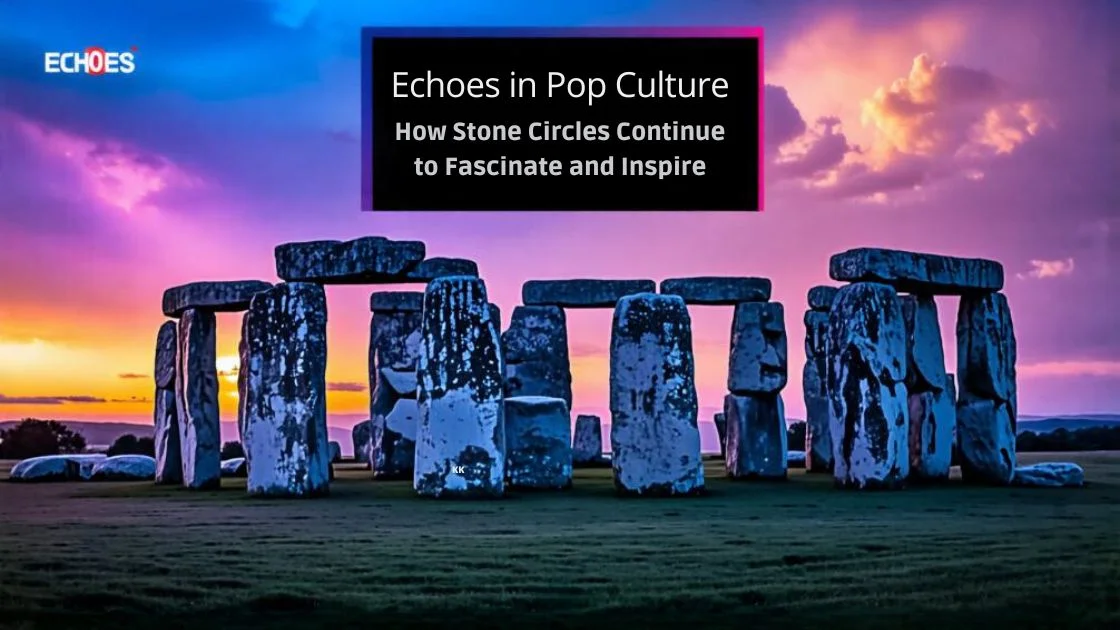You’re on a quest to unravel the celestial enigmas of stone circles. As you explore these ancient astronomical observatories, you’ll decode the harmonious alignment of megaliths with the heavens. Prepare to dissect theories and unearth the methodical precision our ancestors employed to bridge earth and sky.
Your analytical mind seeks the freedom these stone giants promise—a liberation from time, connecting us to the cosmos. Welcome to ‘When Stars Align.’
Key Takeaways
- Stone circles were predominantly found in Northwestern Europe, particularly in Britain, Ireland, and Brittany, dating from the Late Neolithic and Early Bronze Age.
- Stone circles were constructed with communal effort and their purpose is still debated among archaeologists.
- Some of the oldest stone circles in Britain were aligned with solar and lunar positions, indicating a sophisticated understanding of astronomy among the builders.
- Stone circles had various designs, including recumbent stone circles, axial stone circles, and concentric stone circles, each with their own cultural and ritual significance.
Introduction: the enigmatic nature of stone circles across Northwestern Europe
You encounter the imposing legacy of stone circles throughout Northwestern Europe, artifacts from a distant past rooted in the Late Neolithic and Early Bronze Age. These structures bear witness to ancient societies’ ingenuity, whose purposes, though shrouded in mystery, invite rigorous scholarly inquiry.
As you examine their historical context, you’re engaging with a complex narrative that spans millennia and defies simple explanation.
Briefly mention their historical context, dating from the Late Neolithic and Early Bronze Age
The stone circles scattered across Northwestern Europe date back to the Late Neolithic and Early Bronze Age, marking a time when ancient societies began etching their enigmatic presence into the landscape. You can’t help but marvel at how these prehistoric communities invested immense labor and ingenuity into creating what some argue were neolithic observatories. These stone circles weren’t mere markers of territory, but sophisticated structures with potential astronomical functions.
Consider the following key aspects of their construction and purpose:
- Communal Effort: The building of stone circles required collective planning and significant manual labor.
- Astronomical Alignments: Evidence suggests alignments with solar and lunar cycles.
- Cultural Significance: Likely served as ceremonial sites, given the absence of domestic remains.
- Temporal Markers: Stone circles may have operated as prehistoric calendars marking significant seasonal events.
The Mystery and Construction of Stone Circles
You’ll find that stone circles dot landscapes across Britain, Ireland, Brittany, and beyond, an indication of their widespread cultural significance during the Neolithic and Bronze Age periods.
Their construction necessitated a remarkable level of community coordination, from sourcing and shaping the stones to the intricate process of erecting them.
Such endeavors hint at a complex social structure capable of organizing large-scale projects, possibly underpinning the enigmatic purpose these monuments served.
Discuss the widespread distribution of stone circles in Britain, Ireland, Brittany, and other parts of Europe
Stone circles, ancient monuments with a mysterious purpose, dot landscapes across Britain, Ireland, Brittany, and parts of Europe, showcasing a shared architectural tradition that spans vast distances.
You might wonder why these circles are so widespread and what they tell us about the past. Consider the following analytical points:
- Stone circles and astronomy were intricately linked, with many circles aligned to celestial events.
- The distribution suggests a cultural exchange and shared knowledge across seafaring communities.
- Their construction required significant skill, hinting at advanced social organization and cooperation.
- The diversity in design across regions reflects localized adaptations and functions.
As you ponder these stone circles, imagine the freedom they signify: a testament to human ingenuity and the quest to understand the cosmos.
Highlight the communal effort and specialized tasks involved in their construction
Delving into the construction of stone circles, you’ll discover a remarkable testament to the cooperative spirit of our Neolithic ancestors. They combined their skills and labor to create these enigmatic structures. This communal effort likely involved a division of specialized tasks. From selecting and quarrying massive stones, coordinating their transport—often over vast distances—to meticulously planning their placement to align with celestial events.
Such an undertaking required not only physical strength and endurance but also a sophisticated understanding of astronomy and geometry. Each stone circle, therefore, stands as a monument to the collaborative prowess and intellectual acumen of these early societies. They reflect an unyielding desire to impose order on the environment and perhaps to connect with the cosmos.
Astronomical Alignments: A Window to Ancient Astronomy
You’ll find that the oldest stone circles provide compelling evidence of alignments with celestial bodies, notably the sun and moon. This suggests that the builders possessed an advanced understanding of astronomical phenomena.
Considering these alignments, you must evaluate the broader implications of such knowledge on our interpretation of ancient societies and their capabilities.
Explore the evidence suggesting alignments with solar and lunar positions in the oldest stone circles
Archaeological discoveries have revealed that ancient stone circles were meticulously aligned with solar and lunar positions, offering a glimpse into the astronomical sophistication of Neolithic societies. The field of archaeoastronomy has helped decipher these alignments, uncovering the celestial connections inherent in these ancient structures.
- Solstitial alignments: Some circles align with the solstices, where specific stones mark the sunrise or sunset on these pivotal days.
- Lunar standings: Certain stones correspond to extreme lunar positions, reflecting an understanding of the 18.6-year lunar cycle.
- Equinoctial markers: Equinox alignments are evident, where day and night are equal, highlighting an awareness of the solar year.
- Horizon phenomena: Stone placements often relate to specific features on the horizon, indicating a methodical approach to tracking celestial movements.
Discuss the implications of such sophisticated astronomical knowledge among ancient builders
Discovering the sophisticated astronomical knowledge of ancient builders through stone circle alignments gives you a profound insight into their worldviews and practices. This prehistoric astronomy, methodically embedded in megalithic structures, suggests that ancient societies held complex understandings of celestial phenomena.
Such knowledge had practical implications, likely aiding in agricultural cycles and timekeeping, and held spiritual significance, connecting earthbound experiences with the cosmos.
The precision of these alignments indicates an empirical approach to observing celestial patterns, reflecting a society that valued and pursued knowledge systematically. For you, as a modern observer, this can inspire an appreciation for the freedom of thought and inquiry that preceded contemporary science.
It’s a testament to humanity’s timeless quest to comprehend the universe and find our place within it.
Variants in Stone Circle Design and Their Astronomical Significance
You’ll find that recumbent stone circles, with their distinctive horizontal monoliths, may have served specific astronomical purposes, such as charting the moon’s movement across the horizon.
In Ireland, axial stone circles are marked by portal stones, which appear to intricately align with celestial phenomena.
Concentric stone circles, with their nested arrangements, potentially mirror the complexity of the cosmos and could reflect precise observations of astronomical events.
Recumbent Stone Circles: Describe their unique structure and possible astronomical purposes
As you explore the variant designs of stone circles, the recumbent stone circles stand out with their distinctive horizontal monolith, thought to have served specific astronomical functions. These structures are characterized by:
- A large, flat recumbent stone lying between two upright flankers.
- Peripheral stones diminishing in height away from the recumbent stone.
- A deliberate orientation towards the southern landscape.
- Potential alignments with lunar standstills or solstices.
Scholars theorize that these features may reflect a methodical approach to integrating celestial and terrestrial landscapes. The recumbent stone circles could have provided a means to observe, celebrate, or even predict astronomical events, granting a semblance of control over the inexorable passage of seasons and celestial rhythms. This embodiment of the community’s quest for harmony with the cosmos suggests a deeper spiritual significance to these structures.
Axial Stone Circles: Focus on the ‘portal’ stones and their alignment in Irish stone circles
In exploring the variants in stone circle design, you’ll find that axial stone circles in Ireland are distinguished by their towering ‘portal’ stones, purposefully aligned to mark significant astronomical events. These monuments likely served as observatories for ancient communities, methodically tracking celestial movements. The portal stones, situated at a circle’s entrance, are often aligned with lunar cycles, indicating a deep understanding of the moon’s influence on timekeeping and ritual.
Scholars have meticulously documented these alignments, revealing a connection to key lunar events, such as lunar standstills, which occur every 18.6 years. Your appreciation for these structures grows as you recognize their role in navigating the passage of time and seasons, granting a sense of freedom to those who once gazed upon the same skies.
Concentric Stone Circles: Discuss these complex structures and their potential link to astronomical events
Moving beyond the lunar-focused portal stones of axial circles, you now encounter the enigmatic concentric stone circles, whose overlapping rings may have served to chart broader celestial patterns. These structures aren’t mere relics of the past but sophisticated tools that might’ve captured celestial alignments with precision. Consider the following aspects:
- Design Complexity: Concentric stone circles exhibit a level of sophisticated design, suggesting precise planning and knowledge of geometric principles.
- Celestial Markers: The spacing and orientation of the rings may align with significant astronomical events, such as solstices and equinoxes.
- Observational Accuracy: The concentric design could have provided an expanse for accurate observation of the skies, enhancing the tracking of celestial bodies.
- Cultural Context: Understanding these alignments within their cultural context speaks to a society deeply intertwined with the cosmos, valuing freedom through knowledge.
The Ritual and Cultural Significance of Stone Circles
You’ve explored the geometric intricacies of concentric stone circles, and now within the context of their ritual and cultural significance, you’ll discover how their design variants echo astronomical knowledge. Stone circles weren’t mere monuments; they were theaters of the cosmos, where ritualistic practices merged with celestial observations. These ancient architects encoded their understanding of the heavens into the stones’ placement, creating a dialogue between earth and sky.
| Design Variant | Astronomical Alignment | Ritualistic Significance |
|---|---|---|
| Recumbent | Lunar Standstill | Ancestral Veneration |
| Axial | Solstices | Passage of Seasons |
| Concentric | Equinoxes | Life and Death Cycles |
| Multiple Rings | Planetary Movements | Community Gatherings |
| Outliers | Star Pathways | Navigation and Lore |
Each variant holds clues to how freedom was sought in the alignment of human activities with the cosmos.
Delve into theories suggesting stone circles were ceremonial sites, not dwellings
Consider the stone circles as ancient theaters under the stars, where people gathered for ceremonies rather than setting up homes. The astronomical significance of stone circles is underscored by the precision of their alignments, which often correlate with celestial events. These alignments suggest that the stone circles had a purpose beyond the mundane, possibly serving as monumental calendars or symbols of cosmological beliefs.
To grasp the depth of their significance, consider the following:
- Solstice alignments indicate a keen observation of the sun’s path.
- Lunar standstills are marked in some circles, revealing a complex lunar tracking system.
- Stellar alignments suggest a broader celestial mapping.
- The diversity in design reflects a rich variety of astronomical practices and ritualistic purposes.
Through methodical analysis, it’s clear that these megalithic structures weren’t homes but important ceremonial sites linked to the cosmos.
Mention the association of some circles with burial pits or chambers, indicating a ritualistic purpose
You’ll find that some stone circles transcend mere markers of astronomical phenomena and are intimately linked with burial pits or chambers. This association underscores a broader ritualistic dimension, suggesting these sites served dual functions in ceremony and commemoration.
Moreover, the presence of burials hints at a belief in an afterlife or a desire to connect the earthly with the celestial.
The Spread of Stone Circle Construction Techniques
While you explore the enigmatic landscapes dotted with stone circles, it’s important to note that as these structures spread across Europe, some were closely associated with burial pits or chambers, hinting at their ritualistic significance. The diffusion of stone circle construction techniques is believed to have been influenced by the following factors:
- Neolithic Cosmology: Alignments suggest a deep understanding of celestial patterns and a desire to mirror them on earth.
- Ancient Astronomy: Stone circles served as early observatories, reflecting a sophisticated knowledge of the skies.
- Archaeological Discoveries: Excavations reveal a pattern of knowledge transfer through trade and cultural exchange.
- Ritualistic Purposes: The association with burials points to a ceremonial use, beyond mere timekeeping.
This analytical approach underscores how ancient societies valued freedom through their connection with the universe, as evidenced in their megalithic legacies.
Discuss how the construction techniques likely spread via sea routes from northwestern France across Europe
As you delve into the mystery of stone circles, it’s clear that their construction techniques likely sailed from northwestern France to other European shores, often accompanied by burial pits or chambers that underscore their ritualistic essence. The spread of such methods speaks to a cultural heritage that transcended the rugged sea barriers, conveying complex ideologies and technological knowledge.
| Aspect | Detail | Significance |
|---|---|---|
| Sea Routes | Vessels from northwestern France | Facilitated dissemination of megalithic methods |
| Burial Associations | Chambers within or near stone circles | Indicated ritual and ceremonial functions |
| Cultural Continuity | Similar construction across diverse regions | Suggests shared values and interconnectedness |
This analysis posits a prehistoric network of maritime exchanges, where seafaring communities transported not just goods, but also ideas and practices related to stone circle construction, embedding these monuments within the broader narrative of human expression and autonomy.
Highlight the interconnectedness of ancient European communities in sharing architectural and astronomical knowledge
Delving into the architectural marvels of stone circles reveals a tapestry of shared knowledge, where burial associations within these enigmatic structures highlight the ritualistic purposes that once united disparate ancient European communities. The practice of aligning these monuments with celestial events underscores a collective stride in megalithic astronomy.
Consider the following:
- Stone circles often encompass burial sites, suggesting a shared spiritual or ceremonial function across different cultures.
- Archaeological evidence reveals a sophisticated understanding of astronomical phenomena, reflecting a common drive for celestial harmony.
- The uniform architectural techniques imply a widespread exchange of knowledge, hinting at interconnectedness despite geographical separations.
- Ritual activities at these sites likely served to unify communities through common beliefs and practices tied to the cosmos.
Conclusion
You must recognize the intricate interplay between architectural innovation and astrological insight in the construction of stone circles.
As you conclude your exploration, ponder the enduring allure of these monuments and their role in deciphering the astronomical acumen of bygone eras.
These ancient structures serve not merely as relics of the past but as testaments to the sophisticated celestial knowledge of our ancestors.
Reflect on the blend of architectural skill and astronomical precision in stone circle construction
Reflecting on the ancient stone circles scattered across Europe, you’ll find a remarkable fusion of architectural prowess and astronomical accuracy that has stood the test of time. The astronomical alignments of stone circles serve as a testament to the builders’ deep connection with the cosmos.
Consider these key aspects:
- Purposeful Placement: Stones meticulously positioned to frame celestial events, demonstrating both intention and understanding.
- Technical Expertise: Monumental stones transported and erected, showcasing advanced engineering skills.
- Astronomical Precision: Alignments with solstices, equinoxes, and lunar phenomena, reflecting a sophisticated knowledge of celestial cycles.
- Cultural Expression: These alignments likely held significant meaning, possibly for rituals or timekeeping, indicative of the builders’ desire for harmony with the universe.
Analyzing these elements, it’s clear that freedom in thought and innovation were valued by these ancient architects.
Conclude with thoughts on the continuing fascination with stone circles and their significance in understanding the astronomical knowledge of ancient civilizations
Your exploration of stone circles reveals a profound legacy, bridging our present to the astronomical wisdom of ancient civilizations. These ancient mysteries beckon, offering a glimpse into the minds that once contemplated the heavens with a reverence and precision that challenges our understanding.
Methodically aligned with celestial bodies, these stone circles are more than monuments; they’re time capsules of human ingenuity and the longing for cosmic connection.
The enduring fascination with these structures stems from their testament to a shared quest for meaning under the stars—a quest that transcends time. Their significance lies in the remarkable testament they provide to the astronomical knowledge and the cultural importance placed on the cosmos by our ancestors.
Conclusion
You’ve journeyed through time, tracing the celestial prowess of ancient architects.
Their stone circles, more than mere monuments, are revealed as sophisticated observatories, mirroring the heavens.
Aligned with cosmic events, they’ve whispered of solstices, equinoxes, and life’s eternal cycles.
In these megalithic structures, you’ve uncovered a nexus between earth, sky, and the spiritual realm, reaffirming humanity’s enduring quest to comprehend its place within the vast cosmos.



